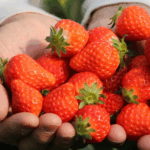Korean strawberries are known for being significantly larger than local varieties. In fact, they can be two to three times bigger than the strawberries commonly found in farms across Indonesia.
But it’s not just the size—Korean strawberries are also much sweeter and deliver a refreshing burst of flavor with every bite. In their home country, strawberries are considered a special fruit, often featured as a dessert.
Curious why Korean strawberries and local strawberries are so different? Let’s dive into the key differences below!
Differences Between Korean and Local Strawberries
South Korea is not only famous for its music and dramas, but also for its fruits. One of the most popular fruits there is the strawberry. These red berries with yellow specks are even exported to several countries around the world.
This has made Korean strawberries widely recognized, both domestically and internationally. At a glance, strawberries from the Land of Morning Calm look quite different from local varieties. The most obvious difference is in size—Korean strawberries are noticeably larger.
But that’s not all. There are several other differences worth noting:
Color Differences
In terms of color, Korean strawberries have a deeper red hue and a glossy exterior. In contrast, local strawberries tend to be lighter in color, with a white base near the stem.
Flavor Differences
When it comes to taste, Korean strawberries are incredibly sweet and offer a refreshing sensation with every bite. Local strawberries, on the other hand, tend to be sour, although some can have a mildly sweet flavor.
Additionally, Korean strawberries have a much more fragrant and enticing aroma—reminiscent of strawberry-scented perfume—something that’s usually absent in local strawberries.
Size Differences
As mentioned earlier, Korean strawberries are about twice the size of local ones. This size difference is largely due to the differing climates. South Korea has a subtropical climate, whereas Indonesia is tropical.
Water Content Differences
Because of their larger size, Korean strawberries contain more water than local varieties. They also have a denser, juicier texture that makes them especially refreshing.
Other Key Differences
In Indonesia, most farmers rely on cross-breeding techniques to influence the size and shape of strawberries. In Korea, however, advanced agricultural technology has enabled the development of many distinct strawberry varieties.
Each variety has its own unique features and strengths. For example, the Damyang Mary Queen Strawberry is known for being larger, denser, and sweeter—and it stores well too.
As the name suggests, this variety is grown in Damyang, South Korea, and sells for around 20,000 KRW (approximately IDR 250,000 per kilogram).
Then there’s the King’s Berry, which went viral online for its size—larger than an egg. Its price is higher, reaching 56,900 KRW (around IDR 725,000).
That’s a breakdown of the differences between Korean and local strawberries. If you’re a strawberry lover, it might be worth trying strawberries from the Land of Morning Calm. You can find them in several supermarkets that stock imported goods.
As for which one is fresher and sweeter, it really depends on your personal preference. If you enjoy a dominant sweet taste, Korean strawberries are a great choice. But if you prefer a tangier, more refreshing flavor, local strawberries might be more to your liking.
So, go ahead and make your choice—and happy tasting!



